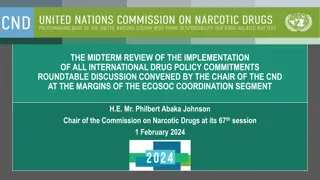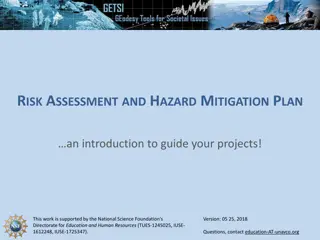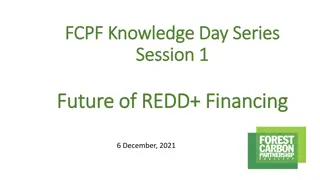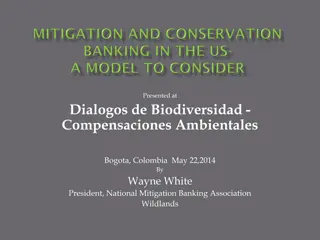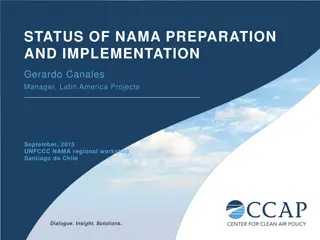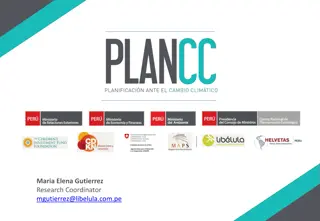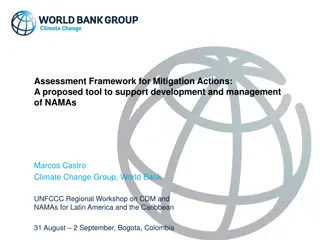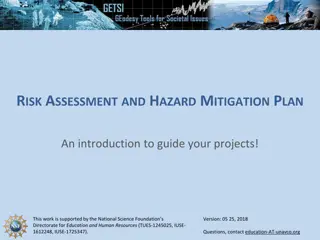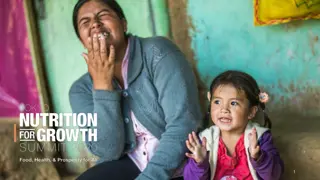Workshop on Tracking Progress of the Mitigation Commitments of Nationally Determined Contributions
Workshop on Tracking Progress of the Mitigation Commitments of Nationally Determined Contributions will focus on enhancing transparency frameworks, modalities, procedures, and guidelines related to NDC tracking provisions. It includes detailed information on mitigation policies, actions, and plans of countries, as well as projections of future GHG emissions and removals. The workshop aims to provide a comprehensive understanding of how countries are progressing towards meeting their NDCs.
Download Presentation

Please find below an Image/Link to download the presentation.
The content on the website is provided AS IS for your information and personal use only. It may not be sold, licensed, or shared on other websites without obtaining consent from the author. Download presentation by click this link. If you encounter any issues during the download, it is possible that the publisher has removed the file from their server.
E N D
Presentation Transcript
Workshop on Tracking Progress of the Mitigation Commitments of Nationally Determined Contributions 23 25 October 2023 Panama City
Presentation: The Enhanced Transparency Framework and Modalities, Procedures and Guidelines with focus on NDC tracking provisions and overview of Common Tabular Formats Fernando Farias Senior Advisor UNEP-Copenhagen Climate Centre Fernando.farias@un.org
Chapter 3 MPG: Information necessary to track progress made in implementing and achieving nationally determined contributions under Article 4 of the Paris Agreement D. Mitigation Policies, Actions, andPlans Thispart aimstopresenta detailedaccountofthe country'sefforts to mitigate climate change, including policies, actions, and plans. The goal is to highlight the measures being taken to reduce GHG emissions and the effectiveness of thesemeasures. A. National circumstances and institutionalarrangements The aim is to paint a comprehensive picture of a country's unique situation that might impact their progress towards NDCs. This includes understanding the institutional framework that supports climate changeinitiatives. E. Summary of GHG Emissions andRemovals This section's goal is to provide a succinct summary of a country's GHG emissions and removals. This information is especially important for countries submitting a stand-alone nationalinventory report. B. Description of a Party s NDC under Article 4 of theParis Agreement, including updates This section aims to provide a detailed account of a country's NDC, including all its parameters and any updates since the last report. The intent is to ensure a clear understanding of the country's climate commitments and any changes therein. F. Projections of GHG Emissions andRemovals The goal here is to present projections of a country's future GHG emissions and removals, based on current mitigation policies and measures. This helps to identify the potential future trajectory ofa country's GHG emissions. C. Information necessary to trackprogress The goal of this section is to outline how a country tracks its progress towards meeting its NDCs. It involves detailing the specific indicators used and sharing the most recent data related to these indicators. G. OtherInformation This section provides a platform for countries to share any additional relevant information that helps understand their progress in implementing and achieving their NDCs. This could include any unique initiatives, challenges, or plans that are relevant to their NDCprogress.
Reportinginformationon trackingprogressof NDCs A. National circumstances and institutional arrangements Each Party shall describeits national circumstances relevant to progress made in implementingand achieving its NDC, including: Government structure Population profile Geographical profile Economic profile Climate profile Sector details Each Party shall provideinformationon: how its national circumstances affect GHG emissions and removals over time. the institutional arrangements in place to track progress of NDCs, including those usedfor tracking ITMOs*, if applicable. legal, institutional, administrative and procedural arrangements for domestic implementation, monitoring, reporting, archivingof informationand stakeholderengagement related to the implementation and achievement of itsNDC. * ITMOs: Internationally transferred mitigation outcomes
Reporting information on tracking progress of NDCs B. Description of a Party s NDC, includingupdates Each Party shall provide a description of its NDC, against which progress will be tracked: Description Target(s)and description,including targettype(s)*,as applicable Targetyear(s)orperiod(s),and whethertheyare single- year ormulti-year target(s),as applicable Referencepoint(s),level(s),baseline(s),base year(s)or starting point(s),and theirrespectivevalue(s),as applicable Time frame(s)and/or periodsforimplementation,as applicable Scope and coverage, including, as relevant, sectors, categories,activities,sourcesand sinks,pools and gases, as applicable Intention to use cooperative approaches that involve the use of ITMOsunderArticle 6 towards NDCs underArticle 4 of the Paris Agreement, asapplicable Any updates or clarifications of previouslyreported information, asapplicable This table is to be used byParties on a voluntary basis, however information items areshall Parties with both unconditional and conditional targets in their NDC may add a row to the tableto describe conditionaltargets This information overlaps with NDC/ICTU, ensure consistencyor explainchanges/updates * Examples of target types: economy-wide absolute emission reduction, emission intensity reduction,emissionreductionbelowa projectedbaseline,mitigationco-benefitsof adaptation actions or economic diversificationplans, policies and measures,etc.
Reporting information on tracking progress of NDCs C. Information necessaryto track progress made in implementing and achieving NDCs Each Party shall identify indicator(s) (quantitative or qualitative;relevant to the NDC) to track progress towards implementation and achievement of its NDC Each Party shallprovide: the informationfor eachselectedindicatorfor the reference point(s), level(s), baseline(s), baseyear(s); and the most recent information for each reportingyear; and compare these description of each methodology and accounting approach used for its NDC target, construction of baseline,andeachindicator identified; [key parameters, assumptions, definitions,data sources, models, IPPC guidelines, metrics,etc] all this informationin a structured summary to track progress: Informationon indicators[reference level; most recent;at the reporting years in between] GHG emissionsand removals consistentwith the scope of its NDC, where applicable; Contribution from the LULUCF sector for each year of the target period or target year, as applicable; Informationon use of ITMOs,as applicable; Each Party with an NDC that consists mitigation co-benefits from adaptation actions and economic diversification plans, shall provide informationon domestic policiesand measures implementedto address socialandeconomic consequencesof responsemeasures.
Reporting information on tracking progress of NDCs C. Information necessaryto track progress made in implementing and achieving NDCs Overview of steps for Parties to track progress of their NDCs by indicators: Step 2 Step 4 Provide most recent information for each indicator, for each reporting year,during the implementation period of NDC Identify the indicator(s) Provide informationon reference point(s), level(s), baseline(s), base year(s) for each indicator (must be updated in case of recalculationsof the GHGinventory) Compare steps2 and 3, to track progress made in implementing NDC Step 1 Step 3 For the first BTR that contains informationon the end year of NDC, provide assessment of whether target is achieved.
Reporting information on tracking progress of NDCs D. Mitigation policies and measures,actions and plans, including those with mitigation co-benefits resulting from adaptation actions and economic diversification plans, related to implementing and achieving an NDC Each Party shall provide information on policies, actions and measures that support implementation of its NDC, focusingon those that have the most significant impact on GHG emissionsor removals and those impacting key categories in the national GHG inventory Tothe extend possible,Parties shall organize reporting of actions by sector (energy, transport, IPPU, agriculture, LULUCF,waste, other), in a tabular format, includingrelevant information on mitigationco-benefits, as applicable: Type ofinstrument (regulatory, economic,other) Status(planned, adopted, implemented) Sectors affected Gasses affected Start year of implementation Implementing entity Name Description Objectives Each Party may also provide information on relatedcosts, non-GHG mitigationbenefits and how these actions interact with each other, asappropriate Each Party shall provideinformation on estimates of expected and achieved GHG emission reductions [FX: encouraged]; and methodologies and assumptions used, to the extentpossible Each Party should: identify PAMsno longerin-place and explain why; provide information on howits PAMsare modifyinglonger-terms trends in GHG emissionsand removals
Reporting information on tracking progress of NDCs E. Summaryof greenhouse gasemissions and removals Each Party, that submits a stand-alonenational inventory report, shall provide a summary of its GHG emissions andremovals. This information shallbe providedfor those reporting years correspondingto the Party s most recent nationalinventoryreport, in a tabular format. the common reporting table 10 emission trends summary Change from [1990][base year][referen ce[year][peri o d]] to latest reported year (%) Reference year/period for NDC(1) (Years2021 to latest reported year) (Years2021 to latest reported year) (Years2021 to latest reported year) GREENHOUSE GAS EMISSIONS AND REMOVALS (Years1991 to 2019) (Years1991 to 2019) (2)Base year 1990(1) 2020 CO2 equivalents (kt)(3) CO2 emissions without net CO2 fromLULUCF CO2 emissions with net CO2 fromLULUCF CH4 emissions without CH4 fromLULUCF CH4 emissions with CH4 fromLULUCF N2O emissions without N2O fromLULUCF N2O emissions with N2O fromLULUCF HFCs PFCs Change from 1990[base year][refer e nce[year][ p eriod]] to latest reported year (%) Referenc e year/perio d NDC(1) (Years 2021 to latest reported year) (Years 2021 to latest reported year) (Years 2021 to latest reported year) (Years1991 to2019) (Years1991 to2019) GREENHOUSEGASSOURCE AND SINK CATEGORIES Baseyear (2) 1990 2020 for CO2 equivalents (kt)(3) UnspecifiedmixofHFCs andPFCs SF6 NF3 Total (withoutLULUCF) 1. Energy 2. Industrial processes and product use Total (withLULUCF) Total (without LULUCF, withindirect) Total (with LULUCF, withindirect) 3. Agriculture 4. Land use, land-use changeand forestry (4) 5. Waste 6. Other (8)
Reporting information on tracking progress ofNDCs F.Projections of greenhouse gas emissions and removals, as applicable Each Party shall report projectionsfor emissionsand removals [FX: encouraged] Projectionswill be indicative on future trends, and will not be used to assess progress towards NDC, unless a Party identifiedthe reported projection as itsbaseline. with additional measures (may) with measures (shall) without measures (may) Projectionsshall begin from most recent year in the Party s inventory report and extend at least 15 years beyond the next year ending in zero or five [FX: extendtheir projectionsat least to the end pointof their NDC] Each Party should provide informationon the methodologyused to develop projections: o Models, approaches, keyassumptions, parameters (GDPrate/level, population growth rate/level, etc.) o Changes in methodology since the latest BTR o Assumptionson policies and measuresincluded in WMand WAMprojections, if included o Sensitivity analysis for theprojections Each Party shall report projections for key indicatorsto determine progresstowardsits NDC Each Party shall include projections on a sectoral basis and by gas, as well as for the nationaltotal Projectionsshall be presented relative to actual inventory data (for preceding years) and be provided with and without LULUCF [FX: can report using less detailed methodology or coverage]
Thank you for your attention! Fernando Farias Senior Advisor UNEP-Copenhagen Climate Centre Fernando.farias@un.org








